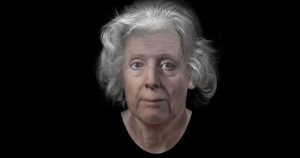
As Halloween approaches, depictions of witches are pretty much impossible to ignore. Amidst all of the fun around sweets, dressing up and indulging in the “safe” terror of creepy films and books, it is easy to forget that at moments in our history, our collective fears around witches resulted in paranoia and cruelty. Bearing this in mind, it is poignant that this autumn Scotland revealed plans for a national memorial to the victims of witch persecutions during the 17th and 18th centuries. The proposed site is where Lilias Adie was buried in 1704, having died in prison from the abusive treatment which she received whilst incarcerated on charges of witchcraft.
Forensic artists at Dundee University were able to produce a portrait of Lilias, and the result is extremely moving. Looking at the kindly, thoughtful face of an older woman, someone you might bump into on the tram, or in the supermarket queue, it is hard to accept the way she was stripped of her life and dignity.
One of the most touching parts of her story was her refusal to implicate other people in her crimes. Lilias confessed to the usual accusations of practising dark magic and having sex with the devil, as most people would have in light of the interrogation methods being used. However, as was the standard practice, when those questioning her wanted names of other witches who joined her gatherings, she made some creative excuses. Apparently, her fellow witches were in masks, so she didn’t know their true identity.
Lilias must have been a clever and compassionate woman to adopt this strategy. Many accused witches gave a litany of names in these circumstances, for entirely understandable reasons, and it should be taken into consideration that the men examining suspects believed that they were under threat from criminals with supernatural powers. Consequently, finding their conspirators was the only way to keep innocent members of the community safe. Witches were supposed to cause illness and death to their neighhours, nowadays the equivalent would be terrorist suspects, understood by the authorities to have allies, still at large, able and willing to use biological weapons. The urgency which modern police officers would feel if they thought that they were dealing with a terrorist in custody, with friends on the outside poised to release anthrax or plague in Edinburgh or London, gives some insight into the mindset of Early Modern witch-hunters. The pressure placed on suspects to disclose fellow witches was immense, and of course, many traumatised individuals kept talking as long as they could in order to delay the execution which was almost certainly awaiting them. In this situation, Lilias must have been quick-thinking, as well as selfless, in the tactics she adopted.
There is no doubt that many of those accused of witchcraft were just in the wrong place at the wrong time. They were suspected because they made others in their community uncomfortable in one way or another, and women living independently or exercising some form of social power (e.g. as midwives or healers) were particularly at risk. Married women and men were not immune from accusations though, and sometimes having offended a vindictive person in the community was all that it took for a finger to be pointed.
Yet having conceded all of which, it should not be forgotten that some of those accused of witchcraft were in fact guilty. Understandably, in reflecting about the past, and certainly in building memorials, we tend to think of the people who were unjustly punished, but in a world in which curses and incantations were common place, some people did indeed try to harm their enemies by magical means. Whilst they may not have made the kind of demonic pact which the lawyers and scholars were looking for, some individuals certainly believed that they could have positive or negative influences on others by using certain words or objects. It was no accident that the line between “cunning folk” (local figures who offered help with healing humans and livestock, as well as assorted supernatural services in relation to finding lost possessions, making butter-churn or solving problems in the home or farm) and witches was remarkably blurred. Both practitioners of magic and their clients believed in its potency.
Needless to say, this raises thought-provoking moral and legal questions. If a person sets out to hurt another, using what they sincerely regard as effective means, surely it is not inappropriate to regard them as culpable and hold them accountable. Of course, the heavy handed and disproportionate response of the legal system is a different matter altogether, but stories concerning witchcraft are certainly far from straightforward.
Related Stories
Plans revealed for national “witches” memorial in Fife (BBC News 12/9/19)
Forensic artist reconstructs the face of Scottish “witch” (BBC News 31/10/17)


